Unlock the profound spiritual truths hidden in the Bible's imagery, from lush gardens to arid deserts, and discover…

Imagery in the Bible
Nearly three-quarters of the Bible is written in poetic or metaphorical language, a fact that might surprise you. This extensive use of imagery, from the lush gardens of Eden to the arid wilderness journeys, not only enriches the text but also encapsulates profound spiritual truths within vivid, tangible pictures.
As you explore the symbolism of water, the contrast between light and darkness, the significance of the fig tree, and the power behind the lion imagery, you'll discover layers of meaning that could transform your understanding of these ancient texts. Let's embark on this journey together, where each symbol opens a door to deeper insights.
Key Takeaways
- The Bible's extensive use of poetic and metaphorical language enriches its spiritual messages through vivid imagery.
- Symbols such as water, light, and the Garden of Eden offer deep insights into themes of purification, divine presence, and human nature.
- Imagery in biblical narratives, like the wilderness journey, facilitates understanding of faith, identity, and divine provision.
- Exploring biblical symbolism, like light versus darkness, reveals profound truths about purity, salvation, and the human condition.
The Garden of Eden
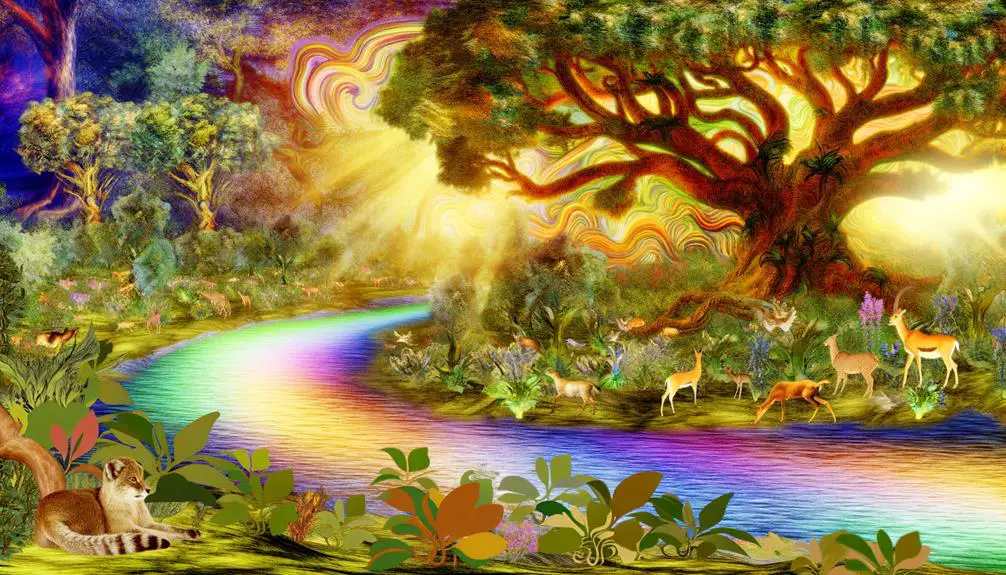
In the biblical narrative, the Garden of Eden emerges as a symbol of untouched perfection and divine generosity, inviting you to contemplate the origins of human innocence and disobedience. This pristine setting serves not only as the backdrop for humanity's inception but also as the stage for the unfolding of the original sin through the temptation narrative. The garden's lush, unspoiled beauty contrasts sharply with the moral failing it witnesses, providing a vivid, almost paradoxical tableau of purity and fallibility.
The temptation narrative, central to Eden's story, intricately explores themes of temptation, free will, and the consequences of disobedience. You're drawn into a complex interplay of divine command, serpentine persuasion, and human vulnerability. The serpent's role is pivotal, embodying the external tempter yet also reflecting internal human struggles against forbidden desires. This narrative underscores the transformative moment when, through an act of disobedience, innocence is shattered, and knowledge of good and evil is attained, marking humanity's departure from divine favor and Eden's untouched perfection.
Original sin, as introduced in Eden, becomes a cornerstone concept in theological discourse, shaping doctrines of human nature and salvation history. It's in Eden's confines that the foundational dynamics of sin, redemption, and the human condition are first explored. The garden, therefore, isn't merely a physical location but a profound symbol of the human journey from innocence to experience, from divine communion to existential estrangement.
Analyzing Eden within the biblical context reveals its layers of meaning, inviting deeper reflection on the themes of temptation, sin, and the quest for redemption that resonate throughout the biblical text and human history.
Symbolism of Water

Just as the Garden of Eden represents a space of complex moral and spiritual dimensions, water throughout the Bible emerges as a multifaceted symbol, reflecting themes of purification, destruction, and renewal. You'll notice that water isn't just a backdrop in the biblical narrative; it's a powerful, active participant in the unfolding of God's plan for humanity.
Consider these pivotal themes associated with water in the Bible:
- Purification: Rituals involving water, such as baptisms, signify cleansing from sin and impurity. This theme reaches its zenith in the New Testament with the concept of ocean baptism, symbolizing the believer's death to sin and rebirth in Christ.
- Destruction: Flood narratives, most notably Noah's Ark, illustrate water's capacity for judgment and divine retribution against wickedness, wiping clean the slate of human corruption.
- Renewal: Following destruction, water also embodies hope and renewal. The receding floodwaters in Noah's story reveal a renewed creation, ready for a fresh start.
- Life: Beyond its destructive capabilities, water is also a source of life. Miraculous events, like Moses striking the rock in the wilderness to produce water, underscore its essential role in survival and God's provision.
Analyzing these aspects, you're invited to appreciate the depth of water's symbolism in the Bible. It's not merely a physical element but a rich, theological metaphor that captures the essence of human experience—our fallibility, God's judgment, and the promise of redemption and new life. Through this lens, water's presence in the scriptures becomes a profound commentary on the nature of divine-human interaction.
The Wilderness Journey

Embarking on the wilderness journey, the Israelites confront a landscape teeming with both spiritual and physical challenges, a pivotal moment that shapes their identity and faith. This passage through the desert embodies a transformative period, under Moses' leadership, where the community grapples with desert temptations and learns to trust in divine provision and guidance.
The wilderness is not just a physical locale but a crucible for spiritual formation. Moses' leadership is instrumental, guiding them through trials and mediating God's laws and promises. The desert temptations serve as both tests and teachings, highlighting the frailties of human nature and the necessity of reliance on something greater than oneself.
Here's a brief overview of key elements associated with the wilderness journey:
Aspect |
Significance |
|---|---|
Desert Temptations |
Challenges that tested faith and obedience, teaching reliance on divine provision rather than earthly comforts. |
Moses' Leadership |
Symbolizes divine guidance, instrumental in navigating physical and spiritual obstacles. |
Identity Formation |
The journey transforms the Israelites from a group of tribes into a unified, covenant-bound community. |
Spiritual Trials |
Serve to refine faith, emphasizing trust in God's promises despite visible uncertainties. |
Divine Provision |
Manna and quail, water from the rock, symbolize God's sustenance and faithfulness. |
Through these elements, the wilderness journey emerges as a profound metaphor for spiritual pilgrimage, encapsulating themes of trial, trust, and transformation under divine guidance.
Light and Darkness
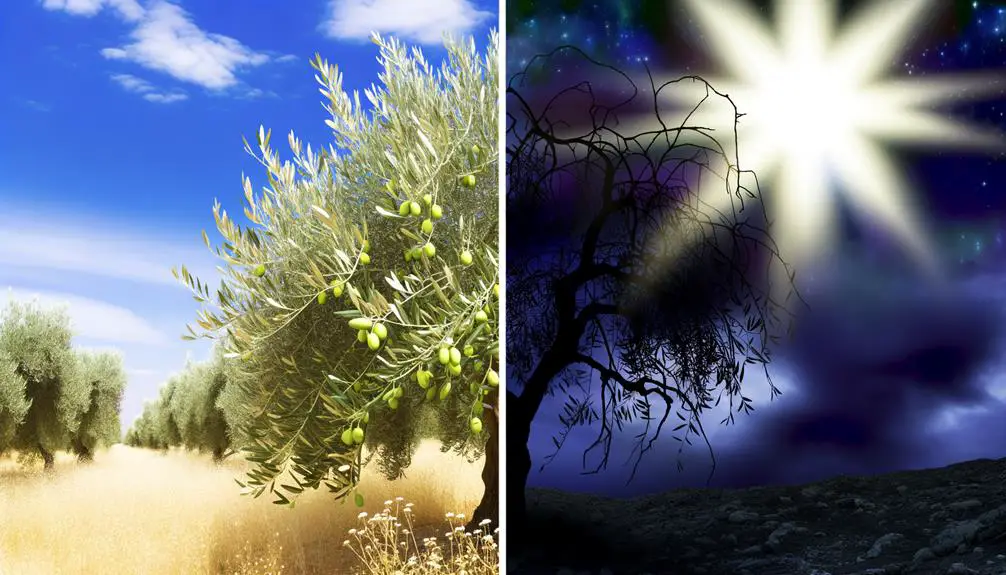
You'll find that the symbolism of light and darkness in Scripture serves as a profound dichotomy, reflecting moral and spiritual states. Light often symbolizes purity, truth, and God's presence, whereas darkness can represent sin, ignorance, or divine judgment.
This contrast not only shapes the narrative and theological framework of the Bible but also invites a deeper understanding of the human condition in relation to the divine.
Symbolism of Light
Within the biblical narrative, the interplay of light and darkness serves as a profound symbol, delineating moral, spiritual, and divine contrasts. The symbolism of light, in particular, is rich and multi-faceted, embodying concepts of divine illumination and sight restoration. Here's how:
- Divine Illumination: Light signifies God's truth and wisdom, guiding humanity out of spiritual darkness.
- Sight Restoration: Miracles of healing blind individuals underscore light's role in overcoming physical and spiritual blindness.
- Purity and Holiness: Light represents purity, contrasting with the impurity symbolized by darkness.
- Hope and Salvation: The presence of light offers hope, symbolizing salvation and the promise of eternal life.
These themes, deeply embedded in biblical texts, invite you to reflect on the transformative power of light in spiritual enlightenment and moral guidance.
Darkness in Scripture
In contrast to the multifaceted symbolism of light, darkness in the Bible often embodies spiritual ignorance, evil, and despair. This imagery isn't just metaphorical; it's deeply embedded in narratives and teachings. For instance, night battles in scripture aren't merely historical accounts; they symbolize struggles against moral obscurity, where the absence of light represents the absence of divine guidance.
Aspect |
Symbolizes |
Example |
|---|---|---|
Night Battles |
Spiritual Warfare |
Gideon's army |
Darkness |
Ignorance/Evil |
Plague of Darkness |
Shadow |
Protection/Death |
Valley of Shadow |
These elements together paint a complex picture of darkness in the Bible. It's a realm where the faithful navigate through challenges, often reflecting the internal battles between good and evil, enlightenment and ignorance.
The Fig Tree Metaphor
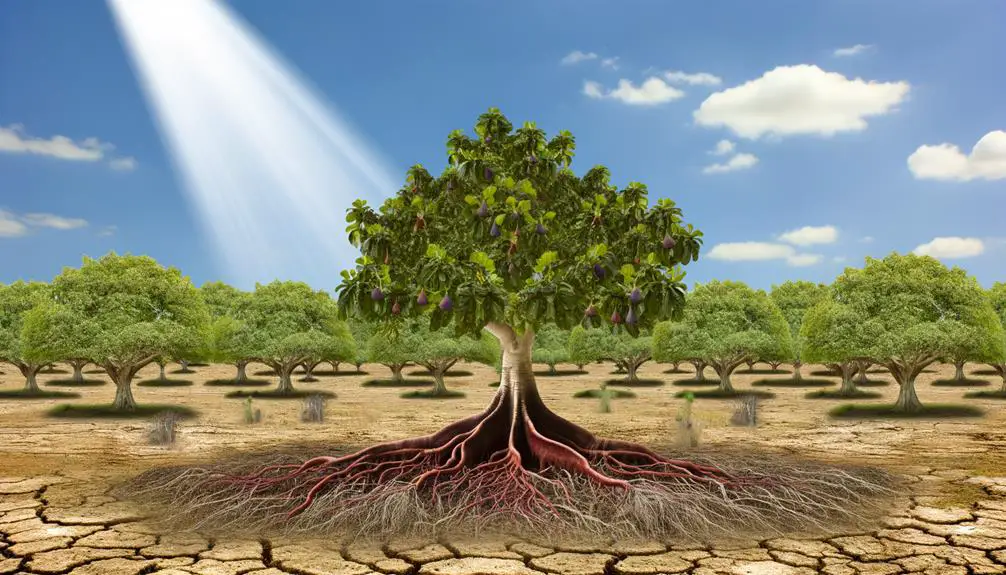
You'll find that the fig tree metaphor in the Bible encompasses a rich tapestry of symbolism, prophecy, and teaching.
Its depiction ranges from symbols of prosperity and judgment to intricate prophecies and lessons taught by Jesus.
This exploration requires a nuanced understanding of its various contexts and meanings across the scriptures.
Symbolism of the Fig Tree
The fig tree serves as a complex symbol in biblical texts, embodying themes of fertility, peace, and divine judgment. Its presence intertwines with fig cultivation and agricultural practices, grounding its symbolism in everyday life while elevating its spiritual significance.
- Fertility: The fig tree's abundant fruit symbolizes prosperity and growth.
- Peace: Its shade offers a place of rest and safety, representing tranquility.
- Divine Judgment: The withering of a fig tree can signify divine displeasure.
- Agricultural Practices: Knowledge of fig cultivation enhances understanding of its metaphorical uses.
Analyzing the fig tree's symbolism requires a grasp of historical agricultural methods, allowing you to appreciate its layered meanings in biblical narratives.
Fig Tree in Prophecy
Building on its symbolic meanings in everyday life and spiritual practices, the fig tree also unfolds layers of prophetic significance within biblical texts. As you delve into the narratives, you'll notice that fig cultivation and the tree's significance are not merely agricultural but deeply prophetic. The fig tree serves as a dynamic symbol, reflecting both judgement and hope, intertwined with the fate of nations and individuals alike.
Aspect |
Significance |
|---|---|
Fig Cultivation |
Represents nurturing, growth, and the potential for prophecy fulfillment. |
Tree's Significance |
Symbolizes Israel's spiritual health and prophetic destiny. |
Fruitfulness |
Indicates divine blessing and prosperity. |
Barrenness |
Warns of judgment and spiritual barrenness. |
Restoration |
Promises renewal and restoration in prophetic visions. |
This metaphor enriches your understanding of biblical prophecies, offering insights into God's plans and the spiritual state of His people.
Jesus' Teachings and Fig
In Jesus' teachings, the fig tree metaphor emerges as a powerful illustration of spiritual readiness and judgment. This metaphor is rich in meaning, offering deep insights into the nature of faith and accountability. Through parable interpretation, you're invited to explore the layers of this metaphor, uncovering its moral lessons.
- *Parable interpretation* guides us in understanding the symbolic use of the fig tree.
- Moral lessons emphasize the importance of bearing spiritual fruit.
- The metaphor serves as a warning against complacency in one's faith journey.
- It underscores the unexpected nature of divine judgment.
Analyzing this metaphor, you gain a nuanced perspective on readiness, productivity, and the consequences of spiritual neglect. This understanding enriches your grasp of biblical imagery, enhancing your appreciation for the depth of Jesus' teachings.
Lions in Biblical Imagery
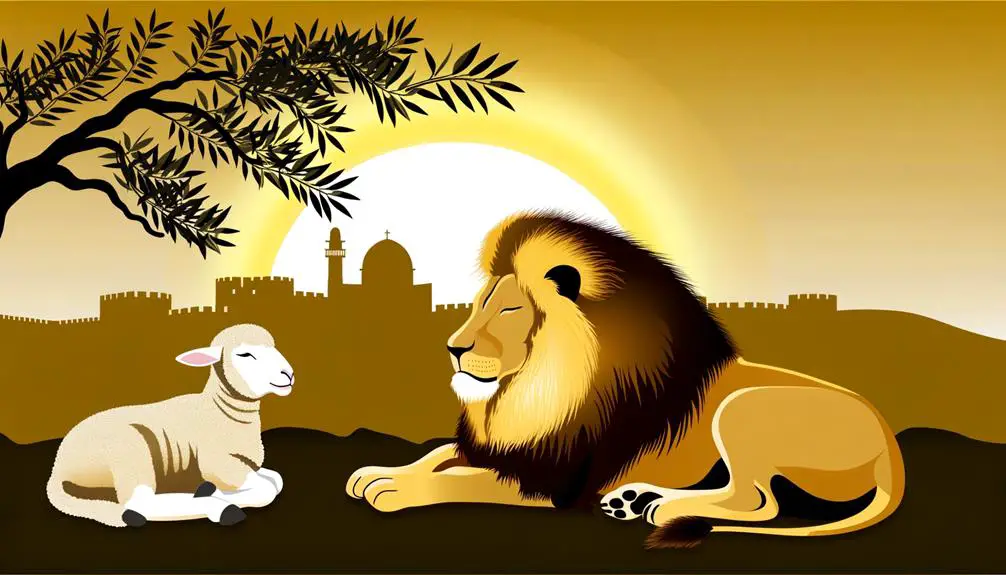
Several passages throughout the Bible employ the imagery of lions to symbolize strength, courage, and the divine protection afforded to the faithful. You'll find that the lion's strength and royal symbolism are deeply intertwined with the narratives of various biblical figures, illustrating not just physical prowess but also moral and spiritual authority. This duality underscores the lion's significance in biblical texts, serving as a potent metaphor for God's power and the majesty of His kingdom.
In exploring this symbolism further, it's essential to consider the context in which these references appear. For instance, the lion is often depicted as a protector, embodying God's unwavering support for His people. This imagery encourages you to reflect on the nature of divine protection, suggesting that it's both fierce and benevolent. Similarly, the lion's association with royalty reinforces the sovereignty of God, reminding you of His supreme authority over all creation.
Moreover, the use of lions to represent the righteous and the wicked in different contexts highlights the Bible's nuanced approach to symbolism. While the lion's strength may signify the righteous who stand firm in their faith, it also warns against the predatory nature of those who oppose God's will. This contrast invites you to ponder the moral choices you face and their consequences.
Frequently Asked Questions
How Does the Imagery of Fire Contrast With Water in Biblical Narratives?
In exploring how fire contrasts with water, you'll notice fire often symbolizes judgment, purifying and punishing, whereas water represents chaos, both destructive and life-giving.
This dichotomy illustrates the complex nature of divine interaction with humanity. Fire purges and refines, aligning with divine retribution, while water's dual role underscores the unpredictable, often chaotic nature of life's trials.
Thus, these elements deeply enrich the narrative, offering layered insights into the human-divine relationship.
In What Ways Do Biblical Authors Use the Imagery of Mountains to Convey Spiritual or Moral Lessons?
When exploring how biblical authors employ mountain imagery, you'll notice they often use it to symbolize spiritual or moral lessons. Mountain covenants, for example, highlight moments of divine agreements, underscoring their elevated importance.
Meanwhile, peak temptations represent the pinnacle of moral testing. These illustrations aren't just geographical details; they're carefully chosen metaphors that deepen the narrative, offering layers of meaning to those traversing their spiritual landscape.
How Is the Concept of Bread Used as Imagery Throughout the Bible to Represent Sustenance and Life?
You're diving into how bread isn't just food but a symbol of life and sustenance. Think about the bread miracles, showcasing divine provision.
Communion, for instance, uses bread to symbolize the body of Christ, underlining its role in spiritual nourishment. This concept is woven throughout the narrative, offering a rich layer of meaning.
It's not just about feeding the body; it's about sustaining the soul, highlighting the intertwined nature of physical and spiritual sustenance.
What Role Does the Imagery of Clothing Play in Conveying Purity, Status, or Transformation in the Bible?
In exploring the role of clothing imagery, you'll find garment symbolism and robe metaphors critical in expressing purity, status, or transformation. These elements aren't just decorative; they carry deep meanings.
A white garment often signifies purity, while a royal robe can denote status. Transformative moments are marked by changes in attire, symbolizing a character's evolution or divine intervention.
This nuanced use of clothing imagery enriches the narrative, offering layers of interpretation and insight.
Can the Imagery of Wind or Breath in the Bible Be Interpreted as a Symbol of the Holy Spirit or Divine Presence, and How Is This Depicted Across Different Books?
Yes, the imagery of wind or breath can symbolize the Holy Spirit or divine presence. This creative breath and wind symbolism is depicted across different books, highlighting a connection to life, renewal, and divine intervention.
For example, in Genesis, God's breath gives life to Adam, symbolizing life-giving power. In Acts, the wind represents the Holy Spirit's arrival, marking divine presence and guidance. These instances show a deep, symbolic relationship with the divine.
Conclusion
In exploring biblical imagery, you've traversed from the lushness of Eden to the arid wilderness, navigating through symbols as diverse as water and light.
Consider the story of Daniel in the lions' den, embodying courage amidst adversity, a testament to the profound layers of meaning within these images.
Such rich symbolism not only enhances our understanding of biblical narratives but also invites deeper reflection on our spiritual journey, urging us to discern the divine in our everyday lives.

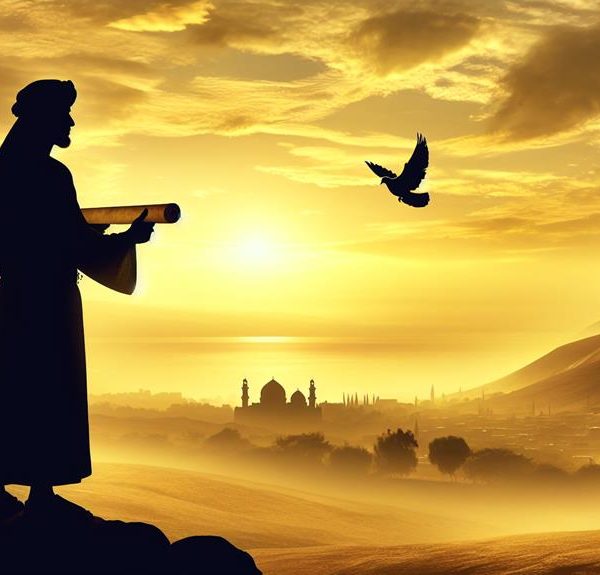
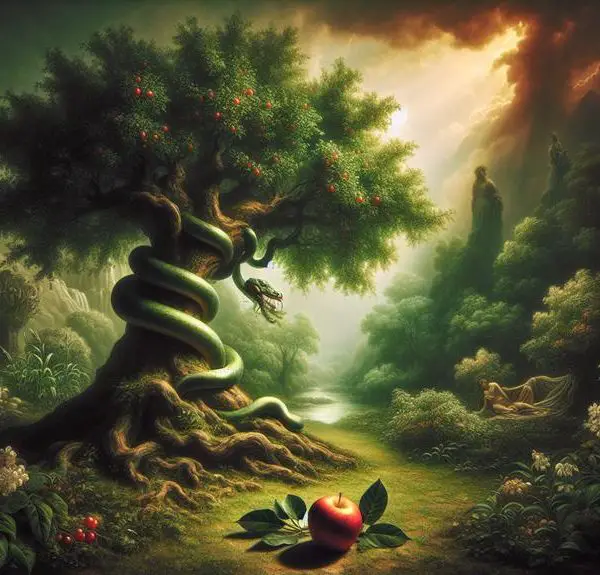
Sign up